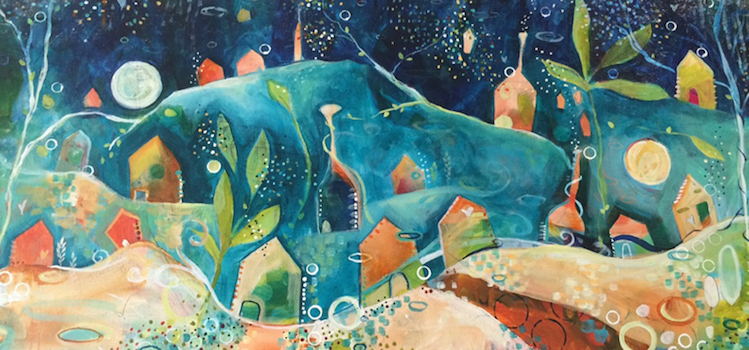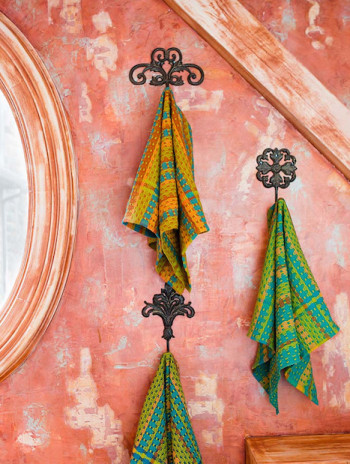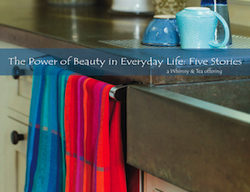When I sit at the loom and throw the shuttle back and forth, I have plenty of time to think as the cloth grows.
Today I’m thinking about the fact that the towels I’m weaving don’t look like the painting that inspired my color choices. And that gets me thinking about my creative process.
Many months ago, a painting called Twilight by Emily Mitchell caught my eye at the café where I like to write. I was drawn to the blues, greens and oranges and to the unusual trees and sloped houses.
As I stared at the painting, I jotted down color names, translating what I saw in the painting into the hues of cotton on my studio shelves. At home I played around with the colors and on my next trip to the café, I photographed the painting.
Nothing clicked.
I put the tubes of cotton away and stashed the printed photo in a pile of papers.
Months later, I came across the photo and tried again. Once again, I pulled lots of colors off the shelf and twisted threads together. This time something clicked and I landed on light orange, rust, kiwi and peacock.
Now these four colors are on my loom and as I weave, I’m struck by the fact that none of the variations I’ve chosen to weave say “Twilight” to me. This is not the first time I’ve drifted from my source of inspiration.
I never intend to duplicate something I’ve seen. I couldn’t even if I wanted to. The painting – or wildflowers, rock walls, or clouds – is a jumping off point. It gets me thinking about color combinations.
I could have started with the idea to create towels called “Twilight.”
However, when I consider this possibility, I feel my body constrict. Doubts and questions surface. How would I go about creating such towels? What if, when I’m finished weaving, the towels don’t read “Twilight” to me? How will I feel?
My mind drifts back to the time I enrolled in a nature drawing class. I grew so stressed about whether my sketch looked like the maple tree in front of me that I dropped the class.
Maybe this is why I’m not big on setting goals. I would likely get focused on the goal and forget to follow my curiosities and, if necessary, set a new goal.
As I continue throwing the shuttles back and forth, I realize that whether I use the Twilight painting to inspire my color choices or decide to weave towels called “Twilight”, I have to make decisions about weave structure, warp and weft colors, and stripe sequences.
However, working with the open-endedness of not having an endpoint in mind, enables me hold my choices more lightly. I experience fewer judgments and fears and enjoy the journey. I can approach the inevitable what-the-hell-was-I-thinking moments with curiosity. I can revel in the process of discovery as the towels unfold and delight in the finished pieces. This is what weaving is about for me.
I get up, stretch and let this new understanding of my creative process settle in my heart. As I wind bobbins for the next towel, it occurs to me: What if I approach life as an open-ended project, a creative experiment?
When I consider embracing life this way, I feel my body relax and open to possibility. I can hold my decisions more lightly. I can let go of judgments and fears and enjoy the journey. I can approach the inevitable what-the-hell-was-I-thinking moments with curiosity. I can revel in the process of discovery as life unfolds.
My invitation to you: Do you like to work towards a specific goal? Do you prefer a more open-ended approach? I’d love to hear what works for you.
Warmly,
Marilyn
P.S. I decided to call these towels Point B — Point A being the painting. I’m curious to see what Point C looks like!
Towel photo credit: Lynne Graves





I enjoyed reading your post, Marilyn.
It’s very much in alignment with what I read about the creative process in the book you recommended, The Path of Least Resistance by Robert Fritz.
I like the idea that creative work is a learning process. We get an idea (a vision if you will) and more often than not we have to go through a series of attempts to realize the idea in a way that pleases us. Sometimes because we have to build our skill, sometimes perhaps our subconscious needs time to work in the background, or perhaps we need to detach from a particular outcome.
With creative projects like writing, I definitely seem to circle back to ideas. I like the organic feeling of the process. I return when I have something more to add.
I love the painting by the way as well as the towels you created using colors from the painting.
Thanks for sharing your process in such a personal way. I feel like I experienced your journey, too.
Judy
You are most welcome, Judy. I’m glad that sharing it was helpful.
I appreciate what you say about the subconscious needing time to work, as well as building skills. It’s possible that I found a combination that clicked for me many months after my first attempt because I planted as seed, if you will, with the first attempt and something was working in the background. Plus, I’d been befriending oranges with other projects.
I hear you on circling back to projects. I find that there are certain color combinations that I keep revisiting.
Marilyn
This brings me back to my days of teaching preschool. Creative arts were involved in all aspects of learning for that age group but we always stressed the process to the families, not the finished product. Many days the teachers had one goal in mind and we had to be flexible in helping the children reach towards that goal – or experience “Point B” and work towards another goal. It was a great lesson to me in keeping the goal broad…no two children would output the same product. And they learned so much about so many things in that process!
~Jessica
PS. I thought the painting was an underwater scene until I looked at it more closely…was it the colors or the wavy lines?? Beautiful just the same!
Thanks, Jessica, for connecting this with our preschool days. You’ve got me thinking about various projects we did and the different “Point B’s” along the way.
Marilyn
This is an interesting post. It speaks to the always present tension between craft and art. Lean too far towards one pole and you lose something in the gestalt of the process. I make a variety of wooden things on my lathe, most notably pens. I make goals for myself: how many will I make today, etc. I usually have an idea of the shape, weight and balance of the item in mind. But wood is a fickle medium. It is full of character (flaws) that will appear suddenly. It is flexible and static. It moves while you work it. It expands and contracts with the moisture in the air. And different woods act differently. So in my actual tooling I have learned to hold my original design lightly. On the fly “design changes” happen all the time. Sometimes the changes inspire a better product. Sometimes, not so much. But the craft is in the technique and the art is in the vision. One is practice, diligence and discipline. The other is what breathes a spark of life into the object. Each feeds the other.
Thank you, Tim, for sharing some of your own process and how you hold your designs lightly.
I’m intrigued by the distinctions you draw between craft and art. I’m not comfortable calling myself an artist. However, if I think of art as vision and a spark of life, as you suggest, I can feel something shift for me.